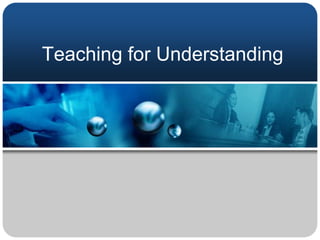
Teaching for understanding
- 2. The Teaching for Understanding Framework focuses instruction on building disciplinary understanding, rather than imparting superficial knowledge.
- 3. Four elements are fundamental to this approach: • Generative topics, • Understanding goals, • Performances of understanding, and • ongoing assessment.
- 4. This performance view of learning encourages students to demonstrate their understanding in the classroom and extend it beyond the school setting.
- 5. Generative topics. • Topics are selected because they are central to a particular subject or discipline around which a unit of instruction will be constructed. EXAMPLES: • leadership in history, • numbers as tools in mathematics, • creativity in the arts, • balance in science, etc
- 6. • Generative topics engage and motivate learners by inviting them to connect what they already know to powerful disciplinary or interdisciplinary understanding.
- 7. Understanding goals. • The goals describe specifically what is important for students to know or do in a particular unit of instruction in relationship to the generative topic. • Goals may be drawn from standards, curriculum documents, and teacher experience.
- 8. • Goals begin with the statement “Students will understand…” and might include such phrases as “…how an author creates, develops, and sustains suspense in a plot” or “…the extent to which water affects the environment.” • Sharing goals with students (and possibly supporting them to help formulate goals) enables them to know what they are expected to learn.
- 9. Performances of understanding. • Students demonstrate their understanding of the goals through sequenced learning experience performances. • Teachers craft performances to be more challenging than ordinary activities and to actively engage their students and require higher order thinking skills.
- 10. • Performances of understanding provide evidence of learning and also extend understanding by requiring students to actively engage in learning: to observe, to make mistakes and correct them, to practice with ideas, and to receive feedback and revise.
- 11. Teaching with Performances of Understanding • As students are engaged in performances of understanding, remind them of the understanding goals the performance should help them achieve.
- 12. • As students are engaged in performances of understanding, try thinking yourself as a “floating coach,” keeping general eye on the progress of students and listening for common questions, confusions, and issues that should be addressed in large group discussions.
- 13. • Ask students to explain their answer, to give reasons, to offer supporting evidence, to make predictions in the process of discussion about written reflection on the performances of understanding.
- 14. • Provide students with criteria by which the performances will be assessed and give them opportunities (especially in more complex performances) to asses their own and others’ work and then to revise it before handing in a final product.
- 15. Ongoing assessment. • Students and teachers use assessments to look for evidence of understanding of one or more of the goals. • Assessment refocuses instruction on the goals and provides feedback that can be used to improve student work.
- 16. • Teachers assess students during important performances throughout the unit, rather than the more typical “too little, too late” single assessment conducted only at a unit’s conclusion. • Assessments may be informal or formal. • They can be self-assessments or may be conducted by teachers, outside experts, or peers.
- 17. • The evidence an assessor is looking for is specified in criteria that identify “quality” work—criteria that students may help develop. • When known by students at the outset of an important performance of understanding, the criteria guide students’ work and focus their attention on what they need to accomplish to demonstrate high-level understanding.
- 18. Questions for Refining Performances of Understanding • Do they require students to demonstrate the understanding stated in your understanding goals? • Do they call for students to apply learning in new situations? • Do they allow students to build and demonstrate understanding?
- 19. • Do the challenge students’ misconceptions, stereotypes, and tendencies toward rigid thinking? • Are they sequenced so that students can engage in them throughout the unit, from beginning to end? • Do they allow students to demonstrate their understanding in a variety of ways (written work, artistic endeavors, and so on)?
- 20. • Are all the Understanding Performances events in which students are creatively thinking and doing with their knowledge? • Are the Understanding Performances student-focused and organized in the sequence: Exploring, Guided Inquiry, and Final Project of Synthesis? • Are the Understanding performances well mapped to your Understanding Goals?
